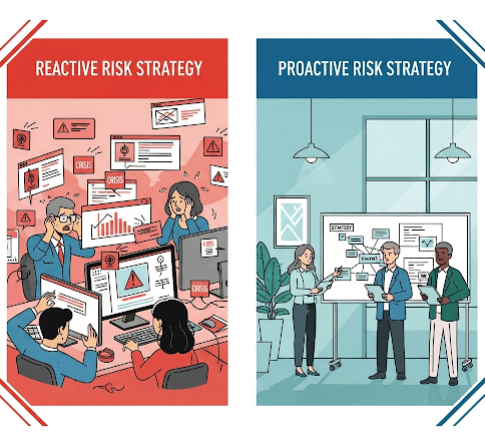- Metrics for Process and Products
- Software measurement
- Metrics for Software Quality
- Risk Management
- Reactive versus Proactive Risk Strategies
- Software Risks
- Risk Identification
- Risk Projection
- Risk Refinement
- RMMM
- RMMM Plan
- Quality Management
- Quality Concepts
- Software Reviews
- Formal Technical Reviews
- Statistical Software Quality Assurance
- Software Reliability
- The ISO 9000 Quality Standards
Reactive versus Proactive Risk Strategies
In software engineering, the approach to managing potential problems can broadly be categorized into two distinct philosophies: reactive versus proactive risk strategies. These strategies determine how a development team addresses uncertainties and threats throughout a project’s lifecycle. While a reactive approach waits for problems to emerge before taking action, a proactive strategy emphasizes anticipating and preparing for risks well in advance. Understanding the fundamental differences between these two approaches is crucial for effective project management and for ensuring the successful delivery of software.
Reactive Risk Strategy
A reactive risk strategy is characterized by a “wait and see” approach. In this model, the project team only responds to risks once they have materialized into actual problems or crises. There is little to no prior planning or anticipation of potential issues.
- Characteristics:
- No Prior Planning: Risks are not actively identified or analyzed before they occur.
- Crisis Management: The focus is on fixing problems as they arise, often leading to hurried and less efficient solutions.
- Unforeseen Impacts: When risks turn into problems, they can cause significant, unexpected impacts on project schedules, budgets, and product quality.
- Stressful Environment: This approach often creates a high-pressure and stressful working environment due to constant “fire-fighting.”
- Analogy: Imagine a team that only calls the fire department after the building is already ablaze, without ever having planned for fire safety.
Proactive Risk Strategy
In contrast, a proactive risk strategy involves actively anticipating and planning for potential risks before they have a chance to affect the project. This approach is highly recommended in software engineering due to the complex and often unpredictable nature of development.
- Characteristics:
- Early Identification: Risks are systematically identified and analyzed at the earliest possible stages of the project.
- Mitigation Planning: Plans are developed to either avoid the risk entirely, reduce its probability of occurring, or minimize its impact if it does occur.
- Contingency Planning: Backup plans are put in place for risks that cannot be entirely avoided.
- Resource Allocation: Resources are strategically allocated to risk management activities upfront.
- Reduced Impact: By addressing risks early, their potential negative consequences are significantly reduced, leading to smoother project execution.
- Analogy: This is like installing smoke detectors, having fire extinguishers, and practicing evacuation drills long before any fire ever starts.

The Preferred Approach
In the realm of software engineering, a proactive risk strategy is almost universally preferred over a reactive one. Although it requires an initial investment of time and resources for identification, analysis, and planning, this upfront effort typically yields substantial benefits. It significantly reduces the likelihood of major project crises, helps maintain adherence to schedules and budgets, and ultimately contributes to the delivery of higher-quality software. Successful software development hinges on foresight and preparedness rather than merely responding to unforeseen problems.
Conclusion
Understanding the distinction between reactive versus proactive risk strategies is fundamental for effective software project management. While a reactive approach merely deals with problems after they occur, a proactive strategy anticipates and prepares for risks, mitigating their potential impact. By adopting a proactive stance, software development teams can enhance their control over projects, reduce unexpected costs and delays, and consistently deliver robust and reliable software solutions. This strategic foresight is key to navigating the inherent uncertainties of software development.
